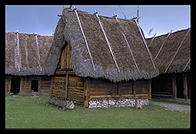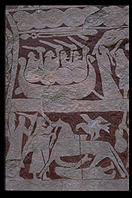
A Brief History
by Eve Andersson

|
A Brief Historyby Eve Andersson |

|
Home : Travel : Sweden : One Article
 About 14,000 years ago, some of the ice covering what is now Sweden started melting. Evidence has been found that there was human life in Sweden by 9000 BCE. The inhabitants were generally hunters and fishers, until about 550-800 CE when Sweden's inhabitants settled and became a primarily agricultural society.
About 14,000 years ago, some of the ice covering what is now Sweden started melting. Evidence has been found that there was human life in Sweden by 9000 BCE. The inhabitants were generally hunters and fishers, until about 550-800 CE when Sweden's inhabitants settled and became a primarily agricultural society.
Then, for the next 250 years, they went through a period of expansion (the "Viking Age"), mostly eastward, as far as the Caspian Sea. The vikings' activities consisted of: trading, plundering and making temporary settlements.
In about the year 1000, the provinces of Sweden combined to form one country. In was around this time, too, that Sweden became Christianized, although the pagan Nordic religion was still around for another century or so.
Sweden continued expanding and had taken over Finland during the 12th and 13th centuries. In 1389, Denmark, Norway, and Sweden united under the Danish Queen Margareta. This union broke up in 1521, after a Danish union king had 80 important Swedish men executed due to conflicts between them and the central government, and the Swedes rebelled.
 After that, Gustav Vasa was elected king (make sure you see the Vasa Museum in Stockholm). For the next 140 years, or so, Sweden battled like crazy, taking over all kinds of places in the Baltic, and by the end was considered a major power in northern Europe.
After that, Gustav Vasa was elected king (make sure you see the Vasa Museum in Stockholm). For the next 140 years, or so, Sweden battled like crazy, taking over all kinds of places in the Baltic, and by the end was considered a major power in northern Europe.
But, you know how that goes; Russia took over Finland, the other provinces that Sweden won were taken back. So now Sweden, while being a great country, cannot be said to be a "dominating" country. And somehow this country of vikings has turned into a country of peaceful, courteous citizens.